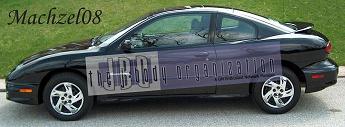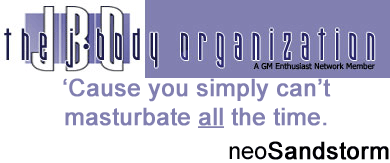not that i intend on doing it myself but i always wondered what is involved in an alignment. i mean what do they adjust or tighten, etc?..........

"Official Jewish J-Body"
All I can recall is watching my dad align the wheels on his old ford. I was like 12. All i remember though is measuring the tie arms and making them the same length, and adjusting them to make the wheels straight.
Computers now are for more accurate then a tape measure.
You're reading my line-break, you are a loser.

A computerized setup is necessary, you can't do it yourself (unless you have access to said equipment).
There are three adjustments to align tires: Toe, Camber, and Caster
Toe is your left-to-right adjustment. It lines your steering wheel up, so that a straight steering wheel will make the car go straight. Also this adjusts how much your ties point toward each other. For normal driving you want 0 toe ( | | ). Positive toe is toward each other ( / \ ), negative is away ( \ / ). This is adjusted on the tie rods on the rack and pinion steering. (The illustrations are as if you were looking down on your car from above it.)
Camber is the amount your tires lean out at the top. For daily driving you want 0 camber ( | | ). If you race, or auto-cross, or anything where any improvement in handling is wanted, then you may want 1 to 3 degrees of negative camber ( / \ ); 5 degrees or more is too much. There is almost no situation where you want positive camber. There are strut mount kits, and strut bolt kits which allow you to adjust the camber. (The Illustrations are as if you were looking at your car from in front of it.)
Caster is how much your spindle leans backward (the spindle is the assembly that holds the tire, including the steering knuckle, hub, bearings). It is not easy to adjust the caster on our J-Bodies. And it is usually not necessary either. Our cars have a few degrees of positive caster. Meaning the top of the spindle is slightly toward the back of the car, compared to the bottom. This is good, when you hit a bump the backward-upward force will be more directly transfered to the strut (not to the frame). More caster will improve handling in rough terrain (with lots of bumps and such). Less caster will improve handling on smooth roads (0 being the best). Negative caster is a bad thing, always. This is something you really don't need to worry about unless you're doing radical changes to you car, like putting it on a tubular frame.
Any questions?

that was great, good explanation. But i wanted to know what is adjust when you change caster and camber. do you just angle of the whole strut assembly? also for toe is the adjustment just a screw or......
like i said i have no intention of doing it myself i've just always wondered what is adjust.

"Official Jewish J-Body"
I beleive it's more-or-less one of those double-side nut things with bolts on either side. On bolt goes to frame, other bolt to wheel assembly or whatever, and they double-sided nut thing pulls/pushes them closer/farther apart.
I could be completly wrong though.
You're reading my line-break, you are a loser. Lurch <3's the c**k.

Toe: The rod end is threaded to the rod, and has a nut double-backin it.
Camber: If you have a kit, see the directions. Otherwise loosen the two big strut to steering knuckle bolts, adjust, then retighten.
Caster: Cutting and Welding the strut mount and/or a-frame is required. I don't know of any kits that make it easier.

o ok
cool thanks, i understand completely now

"Official Jewish J-Body"







